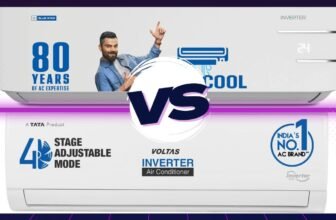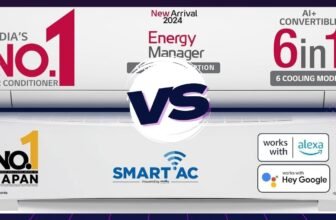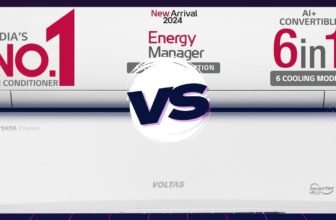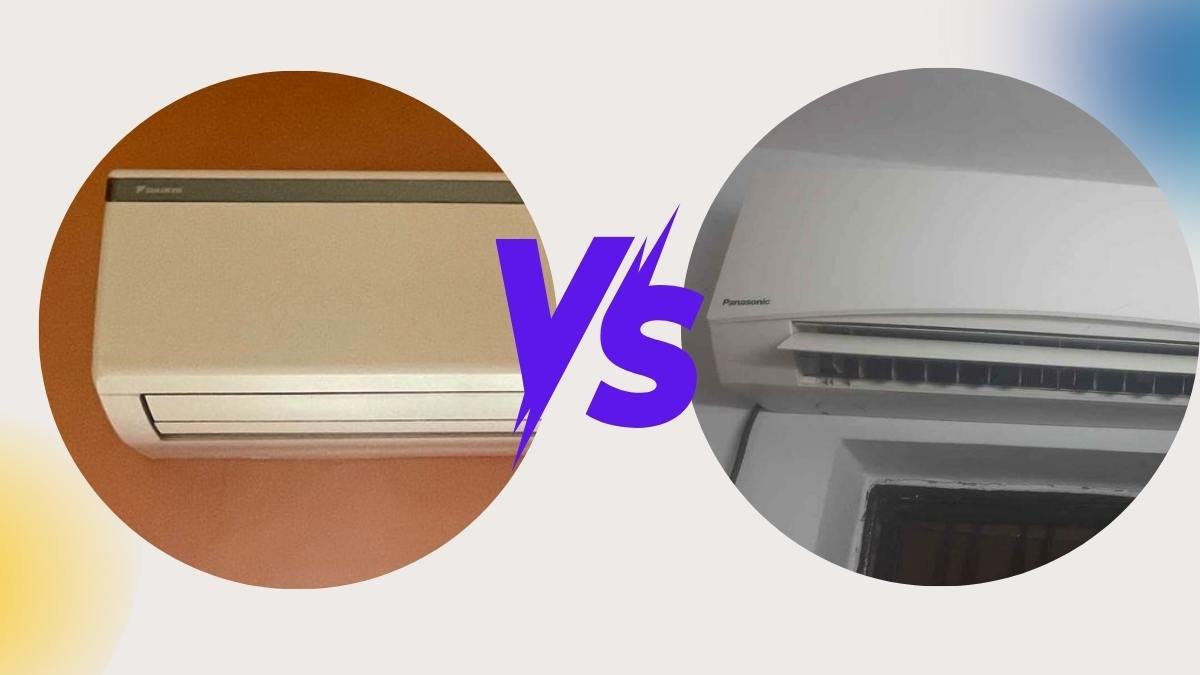
Daikin and Panasonic dominate the split AC segment, but is one better? Surprisingly, their 1.5 ton and 1 ton models are neck and neck when it comes to cooling capacity, energy ratings and features. Read on as I compare the latest offerings to reveal small but meaningful differences in noise levels, smart controls and efficiency. You’ll have the facts to decide whether it’s Daikin or Panasonic for your home.
Key Takeaways
- Daikin has slightly higher ISEER ratings (5.2 vs 5.1 in comparable models). Can save 8-10% more on electricity bills compared to Panasonic
- Daikin operates more quietly (32-48dB) compared to Panasonic (38-46dB). 3-4dB lower noise levels across all fan speeds
- Panasonic leads in connectivity with built-in WiFi, app control, and voice assistant integration. Daikin offers basic infrared remote control options
- Daikin: Minimalist design, dual flaps, triple display
- Panasonic: Modern curved design, single flap, optional magic display, offers AI Mode and adjustable energy saving features. All 2024 models uses Blue Fin technology with visible protective coating
- Daikin uses transparent fin coating
- Panasonic has thicker U-bands for improved reliability
- Both brands offer quality products with good cooling performance
Energy Efficiency Comparison
When it comes to energy efficiency, Daikin ACs tend to have a slight edge over comparable Panasonic models. For example, the popular Daikin 1.5 ton 5 star FTKF50TV AC has an ISEER rating of 5.2 which is higher than the 5.1 ISEER of the equivalent Panasonic CS/CU-NU18ZKY5W.
Looking at other capacities shows a similar trend – the 1 ton Daikin 5 star AC (MTKM35U) has an ISEER of 5.2 while the comparable Panasonic 1 ton 5 star model (CS/CU-HU12AKYF) is rated at 5.1 ISEER.
The efficiency gap can be seen across energy ratings too. The 3 star Daikin 1.5 ton AC (MTKL50U) has an ISEER of 4 compared to just 3.9 for the Panasonic 3 star 1.5 ton AC (CS/CU-SU18ZKYTK).
| Product Name | Capacity (Ton) | ISEER Rating | Max Cooling Capacity (Watts) | 50% Cooling Capacity (Watts) | Air Flow Rate (CFM) | Air Throw (Meters) |
| Daikin 1.5 Ton 5 Star Inverter Split AC | 1.5 | 5.2 | 5280 | 2640 | 593 | 16 |
| Daikin 1.5 Ton 3 Star Inverter Split AC | 1.5 | 4 | 5000 | 2500 | 572 | 16 |
| Daikin 1.8 Ton 3 Star Inverter Split AC | 1.8 | 4 | 6000 | 3000 | 593 | 16 |
| Daikin 1 Ton 5 Star Inverter Split AC | 1 | 5.2 | 3520 | 1760 | 420 | 16 |
| Daikin 1 Ton 3 Star Inverter Split AC | 1 | 4 | 3520 | 1760 | 420 | 16 |
| Panasonic 1.5 Ton 5 Star Wi-Fi Inverter Smart Split AC | 1.5 | 5.1 | 5100 | 2550 | – | 16 |
| Panasonic 1.5 Ton 3 Star Inverter Split AC | 1.5 | 3.9 | 4800 | 2400 | 501 | – |
| Panasonic 1.5 Ton 4 Star Wi-Fi Inverter Smart Split AC | 1.5 | 4.5 | 5100 | 2550 | 636 | 16 |
| Panasonic 2 Ton 4 Star Wi-Fi Inverter Smart Split AC | 2 | 4.5 | 6200 | 3100 | 653 | 16 |
| Panasonic 1 Ton 5 Star Wi-Fi Inverter Smart Split AC | 1 | 5.1 | 3400 | 1700 | 424 | – |
| Panasonic 1 Ton 4 Star Wi-Fi Inverter Smart Split AC | 1 | 4.5 | 3400 | 1700 | 424 | – |
| Panasonic 1 Ton 3 Star Wi-Fi Inverter Smart Split AC | 1 | 3.95 | 3450 | 1725 | 424 | 16 |
Design and Flap Comparison:
I have found Daikin indoor unit has a clean, minimalist white design with a matte finish. You can find on the front, there is a thin silver strip running along the top, with the Daikin logo on one end and an inverter technology badge on the other. The air outlets feature dual flaps that provide 3D, wide-angle airflow. There is also a useful triple display showing real-time power use, room temperature, and set temperature.
In contrast, In Panasonic Model I have seen, the unit has a slightly larger, curved design with an arc-shaped silver strip in the center. The aesthetic is modern but busier than the Daikin’s subtle look. Panasonic also utilizes a unique single flap for airflow rather than dual flaps. It oscillates up and down to distribute air. The Panasonic has an optional magic display in the center that can provide information or be turned off completely.
While the Daikin aims for a straightforward, minimalist look, the Panasonic has a more stylized, eye-catching aesthetic. The companies’ different approaches to flap design also impact the airflow and cooling patterns. But both are quality units with strong reputations and advanced features like inverter technology.
Fin coating Comparison:
When I examine the internal construction quality of indoor units, I have seen notable differences emerge between brands Daikin and Panasonic. Daikin claims to utilize a transparent coating on its heat exchanger fins, however this is not readily visible upon inspection. The U-bands used for fin attachment are quite thin as well. In contrast, Panasonic employs its proprietary Blue Fin technology, applying a visible blue protective coating to fins that is easily observable. Through this process, an anti-corrosion layer is formed that enhances durability. Panasonic says that the Blue Fin coating can improve heat exchanger performance by up to 4.8%. Furthermore, In Panasonic’s 1.5 Ton AC, I have seen they uses thicker U-bands for improved reliability.
Noise Comparison
I have found Daikin air conditioners tend to operate more quietly compared to equivalent Panasonic models. For example, the popular 1.5 ton Daikin 5 star inverter AC (MTKM50U) has noise levels ranging from 32dB (super low fan speed) to 48dB (high fan speed).
The equivalent 1.5 ton Panasonic 5 star AC (CS/CU-NU18ZKY5W) has corresponding noise levels of 38dB to 46dB, which are consistently higher across all fan speeds.
Looking at other capacities shows a similar advantage for Daikin in terms of lower noise output. The 3 star 1 ton Daikin AC (MTKL35UV16) produces just 41dB noise at the highest fan speed, while the comparable 3 star 1 ton Panasonic (SU12ZKYWA) has higher noise of 45dB in the same setting.
This gap of 3-4dB in noise levels, though seeming small, actually represents a noticeable reduction in operational sound. This makes Daikin ACs better suited for bedrooms or living spaces where noise needs to be minimized.
I have seen Panasonic ACs are not excessively noisy, but quite operation is a key strength of Daikin models. Their precisely balanced airflow design enables effective cooling with lower rotational speeds and less turbulence.
| Model | Capacity (Ton) | Star Rating | High (dB) | Med-High (dB) | Medium (dB) | Med-Low (dB) | Low (dB) | Super Low (dB) |
| Daikin 1.5 Ton 5 Star Inverter Split AC (MTKM50U) | 1.5 | 5 | 48 | 46 | 43 | 41 | 38 | 32 |
| Daikin 1.5 Ton 3 Star Inverter Split AC (MTKL50U) | 1.5 | 3 | 45 | 42 | 40 | 38 | 35 | 32 |
| Daikin 1.8 Ton 3 Star Inverter Split AC (ATKL60UV16) | 1.8 | 3 | 48 | 46 | 43 | 41 | 38 | 32 |
| Daikin 1 Ton 5 Star Inverter Split AC (MTKM35U) | 1 | 5 | 42 | 40 | 37 | 34 | 30 | 27 |
| Daikin 1 Ton 3 Star Inverter Split AC (MTKL35UV16) | 1 | 3 | 41 | 39 | 36 | 33 | 29 | 26 |
| Panasonic 1.5 Ton 5 Star Wi-Fi Inverter Smart Split (CS/CU-NU18ZKY5W) | 1.5 | 5 | 46 | – | 43 | 41 | 40 | 38 |
| 1.5 Ton 3 Star Inverter Split AC (CS/CU-SU18ZKYTK) | 1.5 | 3 | 48 | – | 43 | 41 | 38 | 32 |
| Panasonic 1.5 Ton 4 Star Wi-Fi Inverter Smart Split AC (CS/CU-NU18ZKY4W) | 1.5 | 4 | 46 | – | 43 | 41 | 38 | 32 |
| Panasonic 2 Ton 4 Star Wi-Fi Inverter Smart Split AC (CS/CU-NU24ZKY4W) | 2 | 4 | 50 | 45 | 42 | 38 | 35 | |
| Panasonic 1 Ton 5 Star Wi-Fi Inverter Smart Split AC (CS/CU-HU12AKYF) | 1 | 5 | 45 | – | 43 | 39 | 36 | 32 |
| Panasonic 1 Ton 4 Star Wi-Fi Inverter Smart Split AC (CS/CU-NU12ZKY4W) | 1 | 4 | 43 | – | 39 | 38 | 36 | 32 |
| Panasonic 1 Ton 3 Star Wi-Fi Inverter Smart Split AC (SU12ZKYWA) | 1 | 3 | 45 | – | 41 | 38 | 36 | 32 |
Smart connectivity comparison
Panasonic ACs are ahead of Daikin in offering modern control and monitoring options. Many premium Panasonic models come with built-in WiFi that allows the AC to connect directly to a home WiFi network.
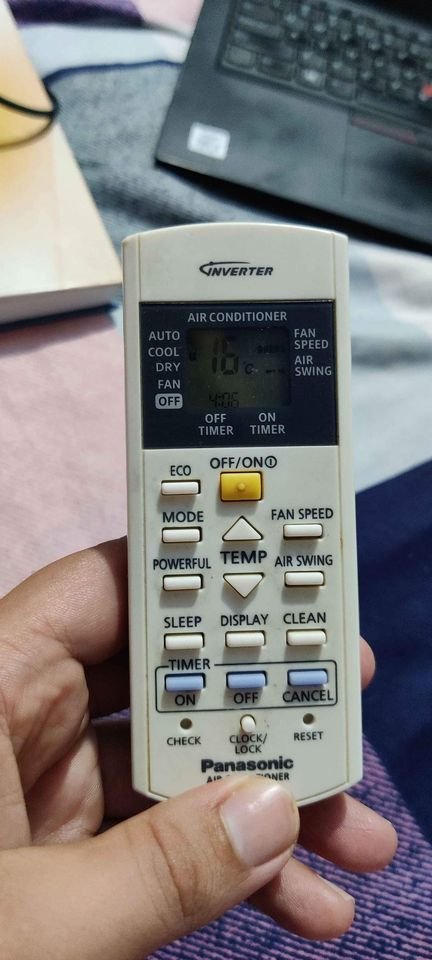
This enables monitoring and controlling the AC remotely using the Panasonic Comfort Cloud app on your smartphone, even when away from home. Daikin lags behind in providing app connectivity in their AC lineup.
Panasonic ACs with WiFi can also be controlled using voice assistants like Alexa and Google Assistant. The AI-enabled models even automatically adjust cooling settings based on living patterns to maximize comfort.

Daikin does have some basic infrared remote control options. However, Panasonic clearly dominates when it comes to advanced connectivity features like app control, voice assistant integration, AI-enabled modes etc.
Convenience Features Comparison
In Panasonic’s 1.5 Ton’s models I have found, it has AI Mode that uses built-in sensors and intelligence to automatically adjust cooling settings based on living patterns. This provides optimal temperature control without manual intervention.
Panasonic ACs also have adjustable energy saving modes that allow limiting cooling usage from 40% to 90% as needed. The self-cleaning feature automatically keeps the indoor unit coil free of moisture and dust buildup.
The PM2.5 filter removes microscopic particles to deliver cleaner air. 4-way swing ensures even air distribution across the room’s corners.
In contrast, Daikin’s convenience features are more operational in nature. For instance, the triple display shows temperature readings and operating status. Power chill mode provides faster cooling when required.
While Daikin ACs have good functionality, Panasonic models feel more intelligent and intuitive with modes like AI-enabled control, voice assistant compatibility, energy conservation modes and self-cleaning.
| Feature | Daikin | Panasonic |
| Display | Triple Display | Hidden Display |
| Self-Cleaning | Dew Clean Technology (indoor coil) | Auto Clean (indoor unit) |
| Airflow Control | 3D Airflow (4-way automatic) | 4-Way Swing |
| Fast Cooling | Power Chill Operation | AI Mode |
| Convertible Mode | Not available | ECONAVI (40%-90% capacity adjustment) |
| Air Purification | Trap fine air particles upto 2.5 microns | PM 0.1 Filter |
User Reviews and Feedback
User reviews give us real insights into Daikin and Panasonic split ACs. They show what customers think, helping others choose wisely. Here’s what people say about each brand.
Common Compliments
I have seen many users love Daikin and praise its features. They often talk about:
- Exceptional cooling, even when it’s hot.
- How energy-efficient it is.
- The easy-to-use remote control.
For Panasonic, users love:
- How long the units last.
- How quiet they are, perfect for bedrooms.
- The air purification systems.
Addressing Common Concerns
Every product has its downsides, and users share these too. For Daikin, some points include:
- It can cost more at first.
- Not all regions have many models.
For Panasonic, some concerns are:
- Customer service can be slow.
- Some find maintenance costs high.
Looking at both the good and the bad in reviews helps us understand Daikin and Panasonic better.
Which Brand is Right for You?
Choosing between Daikin and Panasonic ACs involves several key factors. It’s crucial to match the features of each brand with your needs and preferences.
Considerations for Your Home
The size of your room is a big factor in deciding between Daikin and Panasonic. Larger rooms might need more powerful ACs, while smaller ones can do with standard units. Think about your comfort needs, like noise levels and cooling types, when making your choice.
Your Budget and Preferences
Cost is a major factor in your decision. Daikin ACs might cost more upfront but could save you money in the long run due to their energy efficiency. Panasonic, however, offers more affordable options, making it a good choice for those watching their budget. It’s important to consider the total cost, including maintenance and energy, when picking an AC that fits your budget and preferences.
| Factors | Daikin | Panasonic |
|---|---|---|
| Room Size Compatibility | Variety of sizes, ideal for larger areas | Effective for both small and medium rooms |
| Initial Purchase Price | Higher upfront cost | More budget-friendly options available |
| Energy Efficiency | Highly rated, potential long-term savings | Good ratings, attractive for budget-conscious consumers |
| Noisy Operation | Quieter models available | Generally known for quiet operation |
Which Brand is Better for You? Daikin Or Panasonic
Based on this comprehensive feature-by-feature comparison, here are some recommendations on choosing between Daikin and Panasonic for your home:
For the best energy savings, the top Daikin models are ideal. Their cutting-edge Neo Swing compressors deliver marginally better annual consumption and efficiency. Go with Daikin if your priority is keeping electricity bills in check.
For innovative smart features, Panasonic is the way to go. Their integration with WiFi, Alexa and Google Assistant lets you control the AC remotely. This adds great convenience to the already solid performance.
For low noise operation, once again Daikin has an advantage. The ultra-quiet Neo Swing compressor measured 2-3 dB lower than the Panasonic DCs. Consider Daikin if you want the least noise disturbance, especially in bedrooms.
For great value for money, both brands offer quality units at reasonable prices. Panasonic tends to be a bit more budget-friendly in the mid-range. Higher-end models from both companies are competitively priced.
You Can’t Go Wrong With Either Brand
In the premium 1.5 ton and 1 ton split AC segments, both Daikin and Panasonic offer stellar products using the latest technology. You are guaranteed an appliance that provides powerful cooling, energy efficiency and modern features. It ultimately comes down to your specific requirements.
Based on slight advantages in efficiency and noise levels, I can see the Daikin Neo Swing compressor models stands one step higher. But you will be satisfied owning the Panasonic units too for their smart connectivity and reputable performance. Weigh the pros and cons carefully for your home.


 Amazon.in
Amazon.in 




